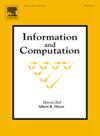Collision-free Robot Scheduling
IF 1
4区 计算机科学
Q3 COMPUTER SCIENCE, THEORY & METHODS
引用次数: 0
Abstract
In this paper, we investigate the problem of designing schedules for completing a set of tasks at fixed locations with multiple robots in a laboratory. We represent the laboratory as a graph with tasks placed on fixed vertices and robots represented as agents, with the constraint that no two robots may occupy the same vertex at any given timestep. Each schedule is partitioned into a set of timesteps, corresponding to a walk through the graph (allowing for a robot to wait at a vertex to complete a task), with each timestep taking time equal to the time for a robot to move from one vertex to another and each task taking some given number of timesteps during the completion of which a robot must stay at the vertex containing the task. The goal is to determine a set of schedules, with one schedule for each robot, minimising the number of timesteps taken by the schedule taking the greatest number of timesteps within the set of schedules. We show that this problem is NP-complete for both star graphs (for robots), and planar graphs (for any number of robots). Finally, we provide positive results for path, cycle, and tadpole graphs, showing that we can find an optimal set of schedules for k robots completing m tasks of equal duration of a path of length n in , time, and time respectively.
无碰撞机器人调度
本文研究了实验室中多个机器人在固定地点完成一组任务的时间表设计问题。我们将实验室表示为一个图形,其中任务放置在固定的顶点上,机器人表示为代理,约束是没有两个机器人可以在任何给定的时间步占用相同的顶点。每个时间表被划分为一组时间步长,对应于通过图形的行走(允许机器人在一个顶点等待完成任务),每个时间步长所花费的时间等于机器人从一个顶点移动到另一个顶点的时间,每个任务需要一定数量的时间步长,在此期间,机器人必须停留在包含任务的顶点。目标是确定一组时间表,每个机器人都有一个时间表,最小化时间表所采取的时间步数,时间表中采取的时间步数最多。我们证明了这个问题对于星图(对于k≥2个机器人)和平面图(对于任意数量的机器人)都是np完全的。最后,我们为路径图、循环图和蝌蚪图提供了积极的结果,表明我们可以找到k个机器人在O(kmn)、O(kmn2)和O(k3m4n)时间内完成长度为n的路径上的m个任务的最优调度集。
本文章由计算机程序翻译,如有差异,请以英文原文为准。
求助全文
约1分钟内获得全文
求助全文
来源期刊

Information and Computation
工程技术-计算机:理论方法
CiteScore
2.30
自引率
0.00%
发文量
119
审稿时长
140 days
期刊介绍:
Information and Computation welcomes original papers in all areas of theoretical computer science and computational applications of information theory. Survey articles of exceptional quality will also be considered. Particularly welcome are papers contributing new results in active theoretical areas such as
-Biological computation and computational biology-
Computational complexity-
Computer theorem-proving-
Concurrency and distributed process theory-
Cryptographic theory-
Data base theory-
Decision problems in logic-
Design and analysis of algorithms-
Discrete optimization and mathematical programming-
Inductive inference and learning theory-
Logic & constraint programming-
Program verification & model checking-
Probabilistic & Quantum computation-
Semantics of programming languages-
Symbolic computation, lambda calculus, and rewriting systems-
Types and typechecking
 求助内容:
求助内容: 应助结果提醒方式:
应助结果提醒方式:


